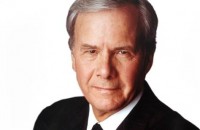“Net neutrality is a dead man walking,” Marvin Ammori stated in Wired last week, citing the probable demise of the FCC’s Open Internet rules in court. I’d agree for a different reason. Net neutrality has been dead ever since the FCC released its net neutrality order in December 2010. (This is not to say the damaging rules should be upheld by the DC Circuit. For many reasons, the Order should be struck down.) I agree with Ammori because we already have the Internet “fast lane” many net neutrality proponents wanted to prevent. Since that goal is precluded, all the rules do is hang Damocles’ Sword over ISPs regarding traffic management.
The 2010 rules managed to make both sides unhappy. The ISPs face severe penalties if three FCC commissioners believe ISP network management practices “unreasonably discriminate” against certain traffic. Public interest groups, on the other hand, were dissatisfied because they wanted ISPs reclassified as common carriers to prevent deep-pocketed content creators from allying with ISPs to create an Internet “fast lane” for some companies, relegating most other websites to the so-called “winding dirt road” of the public Internet.
Proponents emphasize different goals of net neutrality (to the point–many argue–it’s hard to discern what the term means). But if preventing the creation of a fast lane is the main goal of net neutrality, it’s dead already. Consider two popularly-cited net neutrality “violations” that do not violate the Open Internet Order: Netflix’ Open Connect program and Comcast not counting its Xfinity video-on-demand (VOD) service against customers’ data limits
Both cases involve the creation of a fast lane for certain content and activists rail against them. Both cases also involve network practices expressly exempted from net neutrality regulations. The FCC exempted these sorts of services because they are important, benefit the public, and should be encouraged. With Open Connect, Netflix scatters its many servers across the country closer to households, which allows its content to stream at a higher quality than most other video sites. Comcast gives its Xfinity VOD fast-lane treatment as well, which is completely legal since VOD from a cable company is a “specialized service” exempt from the rules.
“Specialized service” needs some explanation since it’s a novel concept from the FCC order. The net neutrality rules distinguish between “broadband Internet access service” (BIAS)–to which the regulations apply–and specialized (or managed) services–to which they don’t apply. The exemption of specialized services opens up a dangerous loophole in the view of proponents.
BIAS is what most consider “the Internet.” It’s the everyday websites we access on our computers and smartphones. What are specialized services? In the sleepy month of August the FCC’s Open Internet Advisory Committee released its report on what criteria specialized service needs to meet to be exempt from net neutrality scrutiny (these are influential and advisory, but not binding):
1. The service doesn’t reach large parts of the Internet, and
2. The service is an “application level” service.
The Advisory Committee also thought that “capacity isolation” is a good indicator that a service should be exempt. With capacity isolation, the ISP has one broadband connection going to the home but is separating the service’s data stream from the conventional Internet stream consumers use to visit Facebook, YouTube, and the like. This is how Comcast’s streaming of Xfinity to Xboxes is exempt–it is a proprietary network going into the home. As long as carriers don’t divert BIAS capacity for the application, the FCC will likely turn a blind eye.
What are some examples? Specialized service is marked by higher-quality streams that typically don’t suffer from jitter and latency. If you have “digital voice” from Comcast, for example, you are receiving a specialized service–proprietary VoIP. Specialized service can also include data streams like VOD, e-reader downloads, heart monitor data, and gaming services. The FCC exempted these because some are important enough that they shouldn’t compete with BIAS Internet. It would be obviously damaging to have digital phone service or health monitors getting disrupted because others are checking up on their fantasy football team. The FCC also wanted to spur investment in specialized services and video companies like Netflix are considering pairing up with ISPs to deliver a better experience to customers.
That is to say, the net neutrality effort has failed even worse than most realize. The FCC essentially prohibited innovative business models in BIAS, freezing that service into common-carrier-like status. Further, we have an Internet fast lane (which I consider a significant public benefit, though net neutrality proponents often do not). As business models evolve and the costs of server networks fall, our two-tier system will become more apparent.


 Today is a bit of a banner day for Bitcoin. It was five years ago today that Bitcoin was first described in
Today is a bit of a banner day for Bitcoin. It was five years ago today that Bitcoin was first described in  The Technology Liberation Front is the tech policy blog dedicated to keeping politicians' hands off the 'net and everything else related to technology.
The Technology Liberation Front is the tech policy blog dedicated to keeping politicians' hands off the 'net and everything else related to technology.